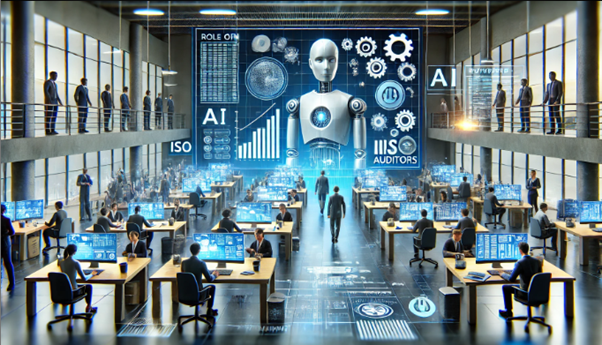
AI in Auditing: Will ISO Auditors Be Replaced by Technology?
Artificial Intelligence (AI) is transforming industries worldwide, and auditing is no exception. Businesses are increasingly adopting AI-powered auditing tools to improve accuracy, efficiency, and compliance in their ISO certification processes.
With AI automating data analysis, risk assessment, and compliance tracking, many wonder: Will ISO auditors be replaced by technology? Or will AI simply enhance their role?
Let’s explore how AI is reshaping the future of ISO auditing, its benefits and limitations, and whether human auditors will still be essential in the years to come.
1. How AI is Changing ISO Auditing
a) Automated Compliance Monitoring
🔹 AI-driven audit software continuously monitors compliance with ISO standards (ISO 9001, ISO 27001, ISO 14001, etc.).
🔹 Real-time data tracking ensures instant detection of non-conformities.
🔹 Reduces manual effort by automating document checks and regulatory updates.
b) AI-Powered Risk Assessment & Anomaly Detection
✔ AI identifies patterns, trends, and potential compliance risks faster than humans.
✔ Machine learning algorithms detect anomalies in financial records, supply chains, and cybersecurity protocols.
✔ AI-powered risk assessments enable businesses to take preventive actions before audits.
c) Smart Data Analytics for Continuous Improvement
📊 AI tools analyze historical audit data to identify areas for efficiency improvements.
📊 Predictive analytics forecast potential compliance risks before they happen.
📊 AI-driven recommendations optimize ISO management systems for long-term success.
d) AI Chatbots & Virtual Audit Assistants
🤖 AI-powered chatbots assist businesses in understanding ISO compliance requirements.
🤖 Virtual assistants help employees prepare documentation, track progress, and ensure audit readiness.
🤖 AI streamlines audit scheduling, reporting, and corrective action planning.
2. Will AI Replace ISO Auditors?
While AI is revolutionizing ISO auditing, it cannot fully replace human auditors. Here’s why:
✅ AI Enhances Efficiency, But Lacks Human Judgment
✔ AI quickly scans large datasets for errors, but human expertise is required to interpret findings and apply contextual judgment.
✔ ISO audits involve risk-based decision-making, which AI alone cannot fully execute.
✅ ISO Auditing Requires Ethical & Strategic Decision-Making
✔ AI follows programmed rules, but ISO audits require ethical considerations, regulatory discretion, and strategic thinking.
✔ AI lacks the ability to assess corporate culture, employee behavior, and leadership commitment to compliance.
✅ Audits Involve Human Interaction & Interviews
✔ ISO audits require face-to-face interviews, factory visits, and employee engagement—areas where AI cannot fully replace human auditors.
✔ Stakeholder engagement and ethical compliance discussions need human auditors for meaningful insights.
✅ AI Can Assist, But Not Certify ISO Compliance
✔ AI can analyze data, generate reports, and suggest corrective actions, but only certified ISO auditors can issue compliance certifications.
✔ Regulatory bodies require human auditors to validate findings and approve ISO certifications.
3. How AI & ISO Auditors Can Work Together
Rather than replacing human auditors, AI is enhancing the auditing process. The future of ISO auditing will involve collaboration between AI technology and human expertise.
| AI in ISO Auditing | Role of Human ISO Auditors |
| Automates compliance checks | Evaluates ethical and regulatory context |
| Detects anomalies and risks | Investigates complex compliance issues |
| Predicts future compliance risks | Provides strategic recommendations |
| Enhances audit speed and accuracy | Conducts interviews and on-site inspections |
| Generates automated reports | Makes final certification decisions |
By combining AI’s speed and efficiency with human expertise and judgment, businesses can achieve more effective, accurate, and insightful audits.
4. How Businesses Can Leverage AI in Auditing
Step 1: Integrate AI-Driven Compliance Tools
📌 Use AI-powered software for real-time compliance monitoring and risk analysis.
📌 Implement machine learning algorithms to detect potential ISO non-conformities.
Step 2: Automate Documentation & Data Analysis
✅ Use AI to automate ISO document preparation, audit scheduling, and reporting.
✅ Reduce human error and manual labor in compliance tracking.
Step 3: Train Auditors to Work with AI
🎓 Train ISO auditors in AI-driven audit tools and data analytics.
🎓 Enable auditors to interpret AI-generated insights and make strategic decisions.
Step 4: Balance AI with Human Expertise
✔ Use AI for automated checks, pattern recognition, and efficiency improvements.
✔ Ensure human auditors oversee final ISO compliance decisions.
5. The Future of ISO Auditing: AI + Human Expertise
Looking ahead, the future of ISO auditing will be a hybrid approach where AI-powered tools enhance audit efficiency, accuracy, and risk prediction, while human auditors provide expert judgment, ethical decision-making, and stakeholder engagement.
🚀 AI will not replace ISO auditors—but it will redefine their role, making audits faster, smarter, and more reliable.
6. Conclusion: AI is the Future of Auditing, But Humans Are Irreplaceable
The rise of AI in auditing is transforming ISO compliance, but human auditors remain indispensable for:
✅ Contextual decision-making beyond AI’s capabilities
✅ Ethical and regulatory oversight
✅ Engaging with employees, suppliers, and stakeholders
✅ Final certification approvals and continuous improvement strategies
💡 Want to integrate AI into your ISO audit process? Contact us today to explore AI-powered auditing solutions that improve compliance, reduce risks, and future-proof your business! 🚀🔍✅